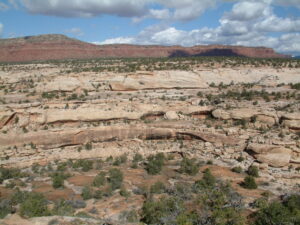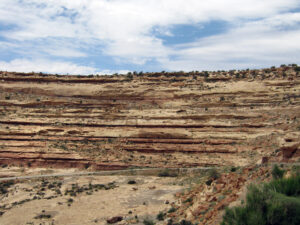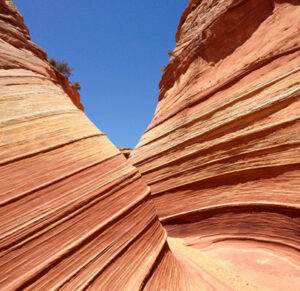The fingerprint of environmental change in the fluvial-aeolian sedimentary record
Summary
- Opportunity to undertake field-based mapping and sedimentological data collection in a stunning setting, such as the Colorado Plateau region of the SW USA.
- Join an integrated research group, with links to international research associates and industry.
- Attend international conferences in Europe, the US and elsewhere.
- Project sits alongside linked research as part of a larger programme.
- Opportunities for career development (academia, internships, industry and beyond).
Rationale
Desert fluvial-aeolian sedimentary systems are sensitive to changes in a wide range of environmental variables, including climate, sea level, sediment supply and tectonic factors. As such, the preserved sedimentary deposits of dryland rivers and desert dune fields record a fingerprint of past environmental change. This research project will use a combined field-based, remote-sensing and modelling approach to characterise a variety of different types of fluvial-aeolian sedimentary system, and will develop a suite models that will enable regional palaeoenvironmental reconstruction for dryland systems that evolved during several different periods in earth history and in different geographic settings in response to dramatically changing environmental conditions. Developed models will be used as predictors of the sediment-system response to future environmental change, especially desertification arising from on-going climate change.
Background
Dryland fluvial and aeolian systems are highly responsive to environmental change. Notably, desert dune fields undergo construction when large volumes of sand-grade sediment stored upwind are made available for aeolian transport and are carried to sites where downstream deceleration induces deposition. Accumulation of aeolian deposits is common where dune bed forms climb over one another giving rise to architecturally complex packages of strata. The long-term preservation of such accumulated deposits is encouraged by the generation of accommodation in subsiding sedimentary basins. Through these mechanisms, thick aeolian successions have come to form widespread sandstone bodies in the geologic record, and their global occurrence spans geologic time from the Achaean to the present-day. Many such successions are now spectacularly exposed and their exhumed sedimentary features provide valuable evidence for past environmental change.
Dramatic and apparently rapid shifts in climate are recorded by fluvial-aeolian sedimentary structures that arose as a consequence of changing aridity, palaeowind strength and direction. Evidence for these changes is recorded in the accumulated deposits of different types of dryland rivers and aeolian dunes and interdunes, and by the nature of their intercalation with deposits of other environments, such as dryland lakes and marine shorelines. Numerous fluvial-aeolian successions of coastal origin record evidence of marine transgression that can be shown to be related to eustatic sea-level rise.
At certain times in Earth history – for example in the late Quaternary, Permian and Carboniferous – global changes in climate and sea level acted in unison to influence aeolian sand supply and thereby directly control when and where aeolian dune fields might be constructed and accumulated. These environmental controls are known to have arisen in response to orbital forcing whereby the Earth periodically oscillated between icehouse and greenhouse conditions in response to changes in solar radiation reaching the planet’s atmosphere – so-called Milankovitch cyclicity. Icehouse conditions associated with global sea-level lowstands, colder temperatures, heightened aridity and compressed but stronger trade-wind belts favour aeolian dune-field construction and accumulation. By contrast, greenhouse conditions favour increased fluvial activity and dune-field stabilization by vegetation or chemical binding agents such as salt precipitates, and destruction whereby dunes are deflated, in some cases to the level of the water table.
The Earth’s periodic oscillation between icehouse and greenhouse conditions means that many preserved fluvial-aeolian successions record a regular and repeating sedimentary signature of the impact of these environmental changes for different times in Earth history (Fig. 1). Moreover, long-term plate tectonic cycles that led to supercontinent assembly and break-up are additionally thought to have influenced the timing and location of occurrence of several extremely large dryland fluvial and desert dune-field systems, for example in hyper arid supercontinent interior basins of Pangea. This research project will explore and decipher these complex relationships.
 |
| Figure 1. The Cedar Mesa Sandstone (white rocks), a Permian aeolian succession exposed at White Canyon, southern Utah, USA. The white cliffs are ~120 m high. This succession records at least 12 aeolian dune-field sequences, each separated by so-called supersurfaces (the prominent horizontal benches), which themselves record long-lived episodes of non-deposition. The sequences and their bounding supersurfaces are thought to have originated in response to global icehouse-greenhouse cyclicity, with each cycle representing ~413,000 years. The cycles likely record the preserved aeolian signature of the so-called long-eccentricity orbital parameter. See Loope (1985) and Mountney (2006) for details. |
Aim and objectives
The aim of this research project is to develop a model to account for the response of preserved dryland fluvial-aeolian sedimentary systems to global drivers of environmental change, including climate, sea level, sediment supply and tectonics. Work will involve field-based data collection from world-class outcrops in the Colorado Plateau region of the South-western United States, analysis of remotely sensed data of modern systems, and lab-based modelling of sedimentary system evolution.
Specific research objectives of this research are as follows: (i) to collect field-derived and remotely sensed data sets describing a range of sedimentary styles from both modern and ancient examples of major dryland fluvial-aeolian systems for which external controls can be shown to have played a key role in determining the preserved system state; (ii) to demonstrate evidence to show that primary allogenic and autogenic controls on preserved fluvial-aeolian sedimentary systems are interdependent and interrelated via a series of complex feedback mechanisms; (iii) to develop a novel and innovative “next-generation” sequence stratigraphic model with which to explain how a range of interlinked environmental factors act to govern the nature of the preserved fluvial-aeolian sedimentary record; (iv) to show how the model can be applied more generally to account for the sedimentology of a range of dryland fluvial-aeolian successions.
Methodology
The project will involve three principal research methods. The first method will involve field-based data collection from a well-exposed aeolian study succession located in the Colorado Plateau region of the south-western United States. This might be the Permian Cedar Mesa Sandstone (Figs 1 & 2), the Jurassic Navajo Sandstone (Fig. 3) or the Jurassic Entrada Sandstone (Fig. 4), depending on the specific interests of the appointed candidate. The field research will involve sedimentary lithofacies analysis to reconstruct fluvial system type, aeolian dune type and the nature of autogenic bed-form behaviour (e.g. migration style), architectural-element analysis to reconstruct how the fluvial and aeolian systems accumulated and became preserved, and sequence stratigraphic analysis to determine how the fluvial-aeolian succession is divided into separate sequences, each representing a distinct phase of dune-field accumulation under a specific set of palaeoenvironmental conditions. The work is expected to involve three separate field seasons resulting in the collection of a large data set that will form the basis for development of a predictive model. The fieldwork will be undertaken amidst beautiful scenery utilising some of the most spectacular outcrops of fluvial-aeolian origin anywhere on the planet.
A second component of the research will collate remotely sensed and literature-derive data to establish the global distribution of preserved dryland fluvial-aeolian successions through geologic time and for different geographic settings. This aspect of the project will relate different types of aeolian system to a range of global environmental controls that are known to have operated at certain times in Earth history or under certain sets of conditions. This work will involve using global climate and tectonic database models. This will establish which of the primary environmental factors were likely operating on known desert systems at different times and in different places throughout Earth history, including those currently active today.
A third research method will involve the use of forward numerical modelling software (already developed by FRG-ERG-SMRG at Leeds) to show how different configurations of environmental controls can give rise to aeolian dune-field successions with predictable sedimentary features.
Together, these three research strands will serve as the basis for the development of the next generation of sequence stratigraphic models for non-marine successions developed in arid continental settings.
Potential for high-impact outcome
A major outcome of this project will be the development of predictive facies and sequence stratigraphic models, which will improve our understanding of factors controlling fluvial-aeolian sedimentary architecture, and system response to environmental controls. Results have implications for the prediction of future desert landform response to currently on-going environmental change. From an applied standpoint, the method to be developed will aid the lithological characterization of subsurface aeolian groundwater aquifers and sites currently being considered for long-term geothermal energy, carbon capture and underground storage (CCUS) and hydrogen storage. Past and ongoing research on similar topics to this, and also undertaken at Leeds, have been funded by NERC to address their mission aims. The appointed candidate will be expected to publish the results of their research in leading pure and applied research journals such as Nature Geoscience, Geology, Sedimentology, Journal of Sedimentary Research Basin Research and Aeolian Research. The principal project supervisor has a long track history of internationally recognized research publications in this field.
Eligibility
Applicants should have a BSc degree (or equivalent) in geology, geology-geography, earth sciences, geophysics or a similar discipline. An MSc or MGeol in sedimentology or geoscience (or similar) is desirable. Skills in field-based geological data collection and sedimentology and stratigraphy are desirable. Experience of using GIS software would be useful, though is not essential.
Training
The project will involve field-based data collection over a series of field seasons. Training in field-based sedimentology data acquisition techniques will be provided. There will be opportunities for the appointed applicant to spend time working closely with one of our industry project partners. Training will be provided in advanced concepts and techniques in clastic sedimentology and stratigraphy, in approaches to basin analysis, and in non-marine sequence stratigraphy. The nature of this research project will enable the appointed applicant to consider a future career in either academia or industry. The successful applicant will join a team of 20+ academic staff, PDRAs and PhD research students who collectively form the Fluvial, Eolian & Shallow-Marine Research Group, which is based at Leeds but benefits from a world-wide network of research associates. The group has been undertaking world-leading sedimentary research for >20 years and is supported by a large consortium of sponsor companies.
CASE Partner
This research has been agreed as a “Partnership Project” (a CASE project). The project aligns with an existing collaboration between Leeds and industry sponsor companies to develop innovative geotechnical database technologies for improved characterization of subsurface sedimentary successions.
 |
| Figure 2. The Permian Cedar Mesa Sandstone exposed at Moki Dugway, southern Utah, USA. This succession represents a position at the edge of a palaeo-desert dune field where repeated climate changes resulted in periodic flooding of the edge of the dune field. The resultant sedimentary succession preserves many different styles of aeolian-fluvial interaction. Red circle highlights a car for scale. |
Recommended Reading
- Bállico, M.B., Scherer, C.M.S, Mountney, N.P., Souza, E.G., Chemale, F., Pisarevsky, S.A. and Reis, A.D., 2017. The wind-pattern circulation as a palaeographic indicator: the case study of the 1.5-1.6 Ga Mangabeira Formation, São Francisco Craton, Northeast Brazil. Precambrian Research, 298, 1-15. doi: 10.1016/j.precamres.2017.05.005
- Bristow, C.S. and Mountney, N.P., 2013. Aeolian Landscapes, Aeolian Stratigraphy. In: Shroder, J. (Ed.), Treatise on Geomorphology. Elsevier, San Diegeo, USA, 11, 246-268.
- Kocurek, G. and Havholm, K.G., 1993. Eolian sequence stratigraphy – a conceptual framework. In: Siliciclastic Sequence Stratigraphy (Eds P. Weimer and H.W. Posamentier). AAPG Mem., 58, 393–409.
- Kocurek, G. and Lancaster, N., 1999. Aeolian system sediment state: theory and Mojave Desert Kelso dune field example. Sedimentology, 46, 505–515.
- Loope, D.B., 1985. Episodic deposition and preservation of eolian sands – a Late Paleozoic example from southeastern Utah. Geology, 13, 73–76.
- Mountney, N.P., 2006. Eolian Facies Models. In: Posamentier, H. and Walker, R.G. (eds), Facies Models Revisited. SEPM Memoir, 84, 19-83.
- Mountney, N.P., 2006. Periodic accumulation and destruction of aeolian erg sequences in the Permian Cedar Mesa Sandstone, White Canyon, southern Utah. Sedimentology, 53, 789-823. doi: 10.1111/j.1365-3091.2006.00793.x
- Mountney, N.P., 2005. Deserts. In: Selley, R.C., Cocks, L.R.M. and Plimer, I.R. (eds), Encyclopedia of Geology. Elsevier, Oxford, 4, 539-549.
- Mountney, N.P., 2004. The sedimentary signature of desert systems and their response to environmental change. Geology Today, 20, 101-106.
- Mountney, N.P. and Jagger, A., 2004. Stratigraphic evolution of an erg margin aeolian system: The Permian Cedar Mesa Sandstone, SE Utah, USA. Sedimentology, 51, 713-743. doi: 10.1111/j.1365-3091.2004.00646.x
- Rodríguez-López, J.P., Clemmensen, L., Lancaster, N., Mountney, N.P. and Veiga, G., 2014. Archean to Recent aeolian sand systems and their preserved successions: current understanding and future prospects. Sedimentology, 61, 1487-1534. doi: 10.1111/sed.12123
 |
| Figure 3. A single large-scale cross-bedded set (~20 m thick) of aeolian dune origin in the Jurassic Navajo Sandstone, Utah-Arizona border, USA. The prominent, well-cemented laminations record temporary but repeated stabilization of the dune lee slope and are likely annual in origin. They record the influence of a monsoon climate whereby the dune advanced rapidly during the windy season but was largely stationary at other times of the year. Such features can be used to reconstruct dune migration rates. This is a very nice place to undertake fieldwork! Photo courtesy of Hollie Romain, former FRG-ERG-SMRG PhD student. |
